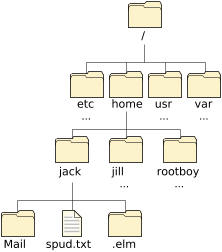A filesystem is often represented as an inverted tree—the root of the tree is shown on the top, and the trunk and branches grow downwards.
 Figure 1. A small portion of a filesystem tree.
Figure 1. A small portion of a filesystem tree.Here we see the root directory contains etc, home, usr, and var, all of which are directories. The home directory contains users' home directories, and one of these directories is shown, jack, as containing two other directories (Mail and .elm) and a file called spud.txt.
A QNX Neutrino system may have many filesystems within it—there's no reason that there should be only one filesystem. Examples of filesystems are things like CD-ROMs, hard disks, foreign filesystems (like an MS-DOS, macOS HFS, or QNX 2 partition), network filesystems, and other, more obscure things. The important thing to remember, though, is that these filesystems have their root at a certain location within QNX Neutrino's filesystem space. For example, the CD-ROM filesystem might begin at /fs/cd0. This means that the CD-ROM itself is mounted at /fs/cd0. Everything under /fs/cd0 is said to belong to the CD-ROM filesystem. Therefore, we say that the CD-ROM filesystem is mounted at /fs/cd0.